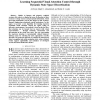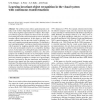868 search results - page 3 / 174 » Learning Object Representations Using Sequential Patterns |
ICRA
2009
IEEE
14 years 24 days ago
2009
IEEE
² Similar to humans and primates, artificial creatures like robots are limited in terms of allocation of their resources to huge sensory and perceptual information. Serial process...
TSMC
1998
13 years 5 months ago
1998
— Parallel algorithms are presented for modules of learning automata with the objective of improving their speed of convergence without compromising accuracy. A general procedure...
IJON
2008
13 years 6 months ago
2008
Image representation has been a key issue in vision research for many years. In order to represent various local image patterns or objects effectively, it is important to study th...
BC
2006
13 years 6 months ago
2006
Abstract The cerebral cortex utilizes spatiotemporal continuity in the world to help build invariant representations. In vision, these might be representations of objects. The temp...
ECAI
2008
Springer
13 years 8 months ago
2008
Springer
Abstract. We propose a framework that learns functional objectes from spatio-temporal data sets such as those abstracted from video. The data is represented as one activity graph t...


